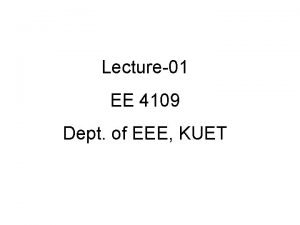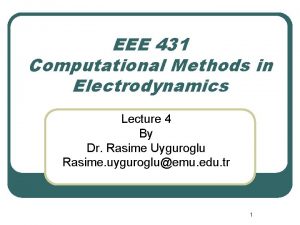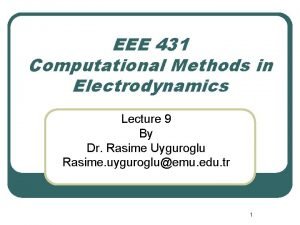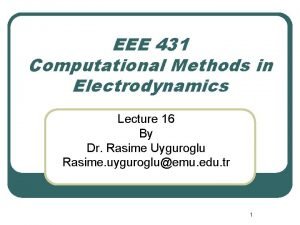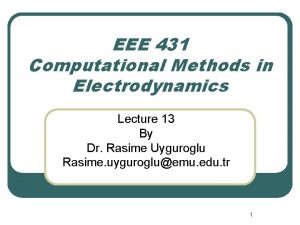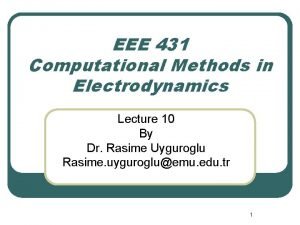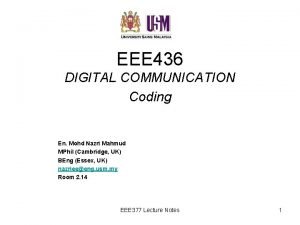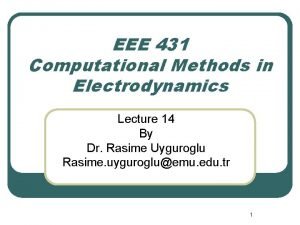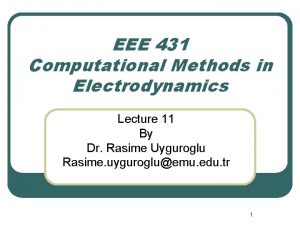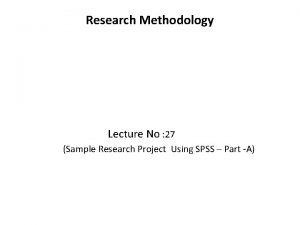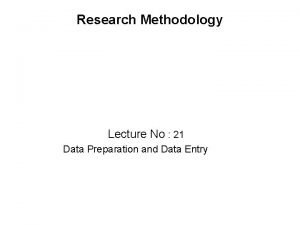Research Methodology Dr Unnikrishnan P C Professor EEE


















































- Slides: 50

Research Methodology Dr. Unnikrishnan P. C. Professor, EEE

Dr. Unnikrishnan P. C. l l l BTech. : EEE, NSS College of Engineering, 1981 -85. MTech: Control & Instrumentation, IIT Bombay, 1990 -92. Ph. D. : EEE, Karpagam University, Coimbatore, 2010 -2016.

Dr. Unnikrishnan P. C. l l l 1986 -1996 : Assistant Professor and Associate Professor, Rajasthan Technical University, Kota, India 1996 -2016 : Assistant Professor, Academic Coordinator, Registrar, Head of Section and Head of the Department at Colleges of Technology, Ministry of Manpower, Muscat, Sultanate of Oman. 2016 - Till Date : Professor, EEE, RSET

Module I q Research Design

Research Process Step IV. Design Research

Step IV. Design Research The research design refers to the overall strategy that you choose to integrate the different components of the study in a coherent and logical way, thereby, ensuring you will effectively address the research problem; it constitutes the blueprint for the collection, measurement, and analysis of data. Note that your research problem determines the type of design you should use, not the other way around!

IV. (a) Preparing the research design: • • • Research design is the conceptual structure within which research would be conducted. The function of research design is to provide complete guidelines for the collection of relevant information with minimal expenditure of time, effort and money. The following points are to be considered while preparing a research design for a particular research problem 1. Objectives of the research study 2. Method of data collection to be adopted 3. Source of information (Sample design) 4. Tool for data collection 5. Data analysis (Quantitative and qualitative)

IV(b). Determining sample design • A sample is segment of the population selected to represent the population as a whole. • Designing the sample calls for 3 decisions – The sample (who will be surveyed) – Sample size (how many people will be surveyed) – Sampling (how should the sample be chosen) • At random (probability sample) • Select people who are easier (non-probability sample) The needs of the research project will determine which method is most effective. . 8

sample design cont. • Samples can be either probability samples or non-probability samples. • Probability samples are those based on simple random sampling, systematic sampling, stratified sampling, cluster/area sampling • non-probability samples are those based on convenience sampling, judgement sampling and quota sampling techniques.

Different Research Designs • Research Design in Case of Exploratory Research Studies • Research Design in Case of Descriptive and Diagnostic Research Studies • Research Design in Case of Hypothesis Testing Research Studies

Research Design in Case of Exploratory Research Studies The major emphasis in this research is on the discovery of ideas & insights Three methods a. The survey of concerning literature: Review hypothesis stated by earlier workers and deriving relevant hypothesis b. The experience survey: Survey people who have had practical experience with the problem

Research Design in Case of Exploratory Research Studies…… c. Analysis of ‘insight-simulating’ examples Suitable in areas where there is little experience available One can mention few examples such as reaction of strangers or marginal individuals, reaction of individual from different social strata

Research Design in Case of Descriptive and Diagnostic Research Studies Descriptive: Describing the characteristics of an individual or group Diagnostic: Frequency with which something occurs with something else • Formulate the objective • Design the method of data collection • Selecting the sample • Collecting the Data • Processing and analyzing Data • Reporting the findings

Research Design in Case of Hypothesis Testing Research Studies Generally known as experimental studies where researcher tests the casual relationships between variables. So the design research means design of experiments. Experimental design originated from agriculture operations, we still use (in a technical sense) several terms in agriculture (such as treatment, yield, plot, block etc. )

Important Experimental Designs a. Informal experimental design • Before and after without control design • After only with control design • Before & After with control Design b. Formal experimental design • Completely Random Design (C. R. Design) • Randomized Block Design (R. B. Design) • Latin Square Design (L. S. Design) • Factorial Designs

Before and after without control design •

• After only with control design

• Before and After with control design

Completely Randomized Design (C. R. Design) The Completely Randomized (CR) design randomly divides the experimental units into t groups of size n and randomly assigns a treatment to each group. Completely Randomized (CR) designs are used whenever the experimental units are homogeneous. Limitations: Individual differences among those conducting the treatments are not eliminated

(C. R. Design) Eg: Two group of students, one going for normal tuitions and another for specialized coaching classes This design is quite common in studies concerning behavioral sciences

Randomized Block Design (R. B. Design) Randomized Block Design differ from Completely randomized designs in that the experimental units are grouped into blocks according to known or Suspected variation which is isolated by the blocks. Eg: In agricultural data variation such as fertility, sand, and wind gradients, or age and litter of animals can be isolated by appropriate blocking

R. B. Design…… Therefore, within each block, the conditions are as homogeneous as possible, but between blocks, large differences may exist.

Advantages of R. B. Design 1. Complete flexibility. Can have any number of treatments and blocks. 2. Provides more accurate results than the completely randomized design due to grouping. 3. Relatively easy statistical analysis even with missing data. 4. Allows calculation of unbiased error for specific treatments.

Disadvantages of R. B. Design 1. Not suitable for large numbers of treatments because blocks become too large. 2. Not suitable when complete block contains considerable variability. 3. Interactions between block and treatment effects increase error.

R. B. Design …. • The randomized complete block design is one of the most widely used designs. If it will control the variation in a particular experiment, there is no need to use a more complex design.

Latin Square Design (L. S. Design) • Frequently used in agricultural research Eg: - An expt. Has to be made through with the effect of 5 different varieties of fertilizers on the yield of a certain crop is to be judged Here two major extraneous factors (Blocking Factors) such as the varying soil fertility and varying seed in different blocks must be taken into consideration.

L. S. Design ……. Fertility Level Seed Differences A B C D E A B C E A B C D In LSD, each fertilizer appear 5 times but is used only once in each row and each column. The two blocking factors are represented through rows and columns. Advantage of LSD is that it enables differences in blocking factors to be eliminated in comparison to the effects of different varieties of fertilizers on the yield of the crop.

Disadvantages: • Interaction between treatment and blocking factors create considerable differences.

What is Sampling ? Population (N) – A group that includes all the cases (individuals, objects, or groups) in which the researcher is interested. Sample (n)– A relatively small subset from a population. (n<N) Sampling Technique- Process of Sample Selection is called Sampling Technique

Census Vs sample Studies In a sample survey, since we study only a subpart of the whole population, requires less money and less time. Considering Non-sampling errors the sample survey are much more accurate than those of census survey. In the case of Census survey sampling errors are absent. But it consumes more time and money. If population is not so large, a Census survey may provide better results than any sample survey.

Sampling errors arise due to the fact that only a part of the population has been used to estimate population parameters and to draw inference about population. Sampling error can be measured for a given sample design and size. If we increase the sample size the precision can be improved. But increasing size of the sample has its own limitations.

Non-sampling errors arise at the stage of collection and preparation of data and thus are present in both the sample survey as well as the census survey. Non-sampling errors can be reduced by defining the sampling units, frame and the population correctly and by employing efficient people in the investigations.

Sample Design A sample design is a definite plan for obtaining a sample from a given population. Main steps of Sample Design 1. Objective 2. Population 3. Sampling Units and frames 4. Size of sample 5. Parameters of Interest 6. Data Collection 7. Non-respondents 8. Selection of proper sampling design 9. Organizing field work 10. Pilot Survey 11. Budgetary Constraints

Types of Sampling Designs 1. Non-Probability Sampling (i) Convenience sampling (ii) Judgement sampling (iii) Quota sampling techniques 2. Probability Sampling (i) Simple Random Sampling 3. Complex Random Sampling (i) Systematic Sampling (ii) Stratified Sampling (iii) Cluster Sampling (iv) Multi-stage Sampling (v) Sampling with Probability Proportional to Size (Vi) Sequential Sampling

Systematic Sampling In systematic sampling only the first unit is selected randomly and the remaining units of the sample are selected at fixed intervals. Systematic sampling is the most practical way of sampling is to be select every ith item on a list.

Systematic Sampling

• Stratified sampling: the researcher divides the population into separate groups, called strata. Then, a probability sample (often a simple random sample ) is drawn from each group • Cluster sampling : used when heterogeneous groupings are evident in a population. It is often used in marketing research. In this technique, the total population is divided into these groups (or clusters) and a simple random sample of the groups is selected

STRATIFIED SAMPLING Stratification: The elements in the population are divided into layers/groups/ strata based on their values on one/several auxiliary variables. The strata must be non-overlapping and together constitute the whole population.

Ex. Stratification of individuals by age group Stratum Age group 1 17 or younger 2 18 -24 3 25 -34 4 35 -44 5 45 -54 6 55 -64 7 65 or older

Ex. Regional stratification

Ex. Regional stratification

Disproportionate Stratified Sample

WHY STRATIFY? • Gain in precision • Practical reasons • Administrative reasons 43

Cluster Sampling Simple random sampling (SRS) not always appropriate! Example • Population of N=324 households • Households arranged into 36 “villages” of 9 households each • Costly to travel between villages • Cheap to travel between households in a village Taking a SRS of n=27 households is a “costly” strategy

Cluster sampling Example (cont. ) • Each village is a primary sampling unit (PSU) sampling unit ( • Each household in a village is a secondary sampling unit (SSU) secondary sampling unit • Take a sample of villages • Sample all households within the selected villages • This is one-stage cluster sampling.

Illustration: Estimation • Cluster sampling: 3 villages out of 36 selected using SRS. 230 360 • Income from sale of goods recorded for each household, and totalled up for village. 180 Estimates: Mean village income is 256. 6666 Total income for area = 256. 6666 x 36 = 9240

In practice… • Units in a cluster tend to be more similar to each other and different to units in other clusters • Cluster sampling often leads to less precise estimates than SRS (opposite concept to stratification) • Trade-off between convenience and precision: • If cluster sampling cheap to do, could take larger sample to help improve precision. 47

Sampling Distribution Suppose that we draw all possible samples of size n from a given population and we compute a statistic (e. g. , a mean, proportion, standard deviation) for each sample. The probability distribution of this statistic is called a sampling distribution.

Sampling Distribution Sampling distribution of the mean – A theoretical probability distribution of sample means that would be obtained by drawing from the population all possible samples of the same size.

Central Limit Theorem Ø No matter what we are measuring, the distribution of any measure across all possible samples we could take approximates a normal distribution, as long as the number of cases in each sample is about 30 or larger. Ø If we repeatedly drew samples from a population and calculated the mean of a variable or a percentage or, those sample means or percentages would be normally distributed.
 Promotion from assistant to associate professor
Promotion from assistant to associate professor Eee kuet
Eee kuet Analog communication
Analog communication Eee ankara
Eee ankara Eee 121
Eee 121 Eee 431
Eee 431 Eee 302
Eee 302 Eee 302
Eee 302 Tahvel.edu.eee
Tahvel.edu.eee Eee 431
Eee 431 Eee 431
Eee 431 Eee 431
Eee 431 Eee 431
Eee 431 Eee 145
Eee 145 Eee
Eee Lempel-ziv coding in digital communication
Lempel-ziv coding in digital communication Eee 431
Eee 431 Eee 431
Eee 431 3 phase short circuit
3 phase short circuit Quality factor of rlc circuit
Quality factor of rlc circuit Eee241
Eee241 Eee
Eee Animacionet
Animacionet Eee
Eee Android (linux-based)
Android (linux-based) Powere
Powere Eee note
Eee note Diu eee faculty
Diu eee faculty String conversion
String conversion Eee components
Eee components Eee office
Eee office Eee office
Eee office Metu
Metu Eee components
Eee components Eee 202
Eee 202 Example of qualitative vs quantitative
Example of qualitative vs quantitative Objective of research problem
Objective of research problem Paradigm vs model
Paradigm vs model Objectives in research methodology
Objectives in research methodology Research methodology flow chart
Research methodology flow chart Steps of research proposal
Steps of research proposal Criteria of goodness of a measurement scale
Criteria of goodness of a measurement scale Dimensions of a research
Dimensions of a research Research methodology
Research methodology Example of project methodology in project proposal
Example of project methodology in project proposal Reviews data for consistencies.
Reviews data for consistencies. Process of research definition
Process of research definition Research methodology contents
Research methodology contents What are variables in research methodology
What are variables in research methodology Methodology section research paper
Methodology section research paper Define research methodology
Define research methodology

